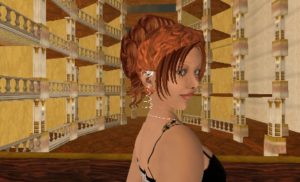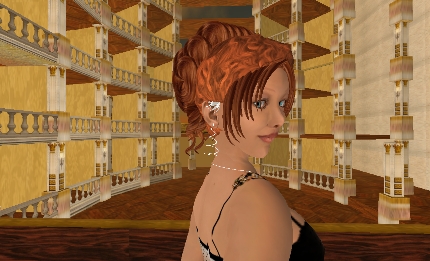The “older” you are in Second Life®, the more you understand the changes that this world is subject to. Some call it “accelerated change” ? virtual worlds being what they are, there are ways to simulate real processes much quicklier than in “real life”, thus, the hectic and ever-changing nature of Second Life.
First Generation ? “Tekkie Wikkies”
First-generation SL users were mostly a mix of gamers (who came to SL just because they wished to see “yet another MMORPG” and found out what SL’s all about) and programmers (attracted by the advertising promising SL to be a next-generation, rapid-prototyping, games development platform). This is what Prokofy Neva calls the “tekkie wikkies” ? a generation of early adopters who came to see the marvelous new technologies available in Second Life, and get bedazzled (pun intended!) by it.
They’re still Second Life’s most active supporters, enthusiastic in-world users, and untiring evangelisers. Yes, they’ve found out ? like the rest of us, I suppose ? that SL is neither a game, nor a games development platform, although it more resembles the latter than the former: it’s a crippled games development platform. You can do games in SL, but don’t expect to be able to replace Counterstrike or World of Warcraft or whatever you fancy with a SL-developed MMORPG.
Still, the roots of SL’s population are very strongly grafted on top of these early adopters, the “core” of what this world has to offer. Just take a look at who did the LSL wikis or who gets Linden Lab’s thanks for helping to debug and test each new version. Most of them aren’t ever tired of Second Life (yes, for them, it’s an ever-changing challenge!) and will probably be around until the bitter end (whatever that means).
One thing this core group never really understood was the economics of SL ? not surprisingly, when most started, there was content, but no money (thus, no economy). People ganged together to do creative things for free. The world was, of course, much smaller ? Anshe Chung has now her own subcontinent which is larger than what SL was in late 2003, for instance ? and everybody knew by name everybody else. There were (and still are!) strong bonds of fellowship among the earliest adopters.
This group also increased over the time, “recruiting” new, similar-minded residents: people more interested in creating new things with SL, tying it to off-world applications, pushing the limits of the Linden Scripting Language ? in a word, testing the technology and seeing what could be done with it, and how far it was possible to push the limits. They are the ones who started to understand what creates lag and what doesn’t; they exploited bugs and “incorrectly” programmed things in SL to give us astounding new effects, completely unforeseen by SL’s creators. A few, of course, in due time, “upgraded” to become Linden Lab employees as well.
Second Generation ? Content Barons
A second generation of users were much less technological, but aesthetically oriented. These are what today are called “content barons”. Instead on focusing on technology by itself, they concentrated all their efforts in making an empty world into a living, colourful one. They’re the builders, the texturizers, the vehicle and weapon designers, and, of course, the clothiers. In a sense, they also exploited LL’s platform to the utmost, but in a completely different direction. Primmed shoes and primmed hair addressed a shortcoming that LL never managed to fix: hair and shoes are simply ugly, and the talented designers worked around it. The Sl History Wiki records Mikiloo Murphy (now Ming Chen) as being the first person ever to wear prim hair (still in Beta), so this attempt to aesthetically enhance SL’s content has started well in our past.
In any case, this second generation is the one responsible for how Second Life looks like today. If there is something like a “SL artistic trend”, it was this group that has created it. Companies/groups like Spellbound, Bedazzle, or Avalon are children of this generation, organising themselves as groups of talented designers who have a certain “style” which they have brought to SL. Also, it’s impossible to imagine what SL would look like without the creations of the Midnights, Aimee Weber, Nephilaine Protagonist (Pixel Dolls), Palomma Casanova (DoveVogue), or Namssor Daguerre (Second Skin, which is installed in your computer and not inside SL); they set standards of quality in clothing, texturing, and also building, that virtually changed the face of the world.
This group also brought something else to Second Life: commerce.
Third Generation ? Commerce
With the willingness to trade-off learning everything by yourself for buying ready-made, high-quality items done by professional designers, commerce and the economy flourished. Not susprisingly, Anshe Chung began her work in SL as a clothes designer, and transitioned to a 3rd generation SLer: by buying land for her shops, she became a land baroness herself, and now most people forget how wonderful her designs used to be and only remember Anshe as the leading force in SL’s economy.
She’s not the only one, of course, just the most successful one 🙂 But these days, 3rd generation SLers join SL for the explicit purpose of learning how the market forces in SL work and establish themselves as the “best in town”. It’s interesting to see how many professional designers look at SL as simply a market opportunity; they were used to do buildings, furniture and clothes in other MMORPGs, or sell their digital creations on e-Commerce & community sites like Renderosity. Now they’re doing it in Second Life as well. Yes, we all know that you won’t be rich easily by selling your content in SL, but you can make money without a shadow of doubt, if you’re good enough.
This group is also what Prokofy Neva is betting on to bring forward the Metaverse: a place where economy/commerce, culture and arts flow together, and where people can have their “alternate lives” just because they’re economically feasible. Many of the talented designers have in SL a hobby that “pays off”. This makes them very strongly bound to SL, and will not leave SL easily: they see it as a market opportunity, a niche to exploit, a chance to get some money from your hobby ? and have a tremendous lot of fun by doing so! The truth is, these are the ones who populate the Metaverse and make it live. It’s thanks to them that we have 250 or so events per day (contrast with around 10 per day before 3rd generation SLers became seriously involved in SL), that things like the e-Commerce sites (SL Boutique, SL Exchange, Gigas/SecondServer) are possible at all, that we start to have urban planning in communities (people wish to sell their wares more easily; customers want nicer environments, friendlier access to shops/malls, better customer support… and so on, mimicking the real world.
No matter how successful this 3rd generation has been, the truth is, we can’t all live off Second Life, although a few of us certainly can. What is there for the rest of us?
Fourth Generation ? RL work in SL

Enter the fourth generation of SLers.
This is the infamous group that says: “SL is not a game but a platform“. At the forefront of their thought is the idea that it’s too soon to have a self-sustainable Metaverse, where the money in circulation is able to pay the (real world) bills. That may be possible in 2015 or so, when the Linden dollar (L$) is high enough for the exchange to US$ be worth making SL commerce viable as a “real life job” for perhaps 70-90% of the population. We’re still not there yet ? perhaps less than 1% are able to “live off” SL, and that is certainly a good sign, but the growth must be much faster to allow a larger group of people to live off SL as well.
The second point is that SL is simply not big enough. We must cross the one-million-users mark first to have critical mass. And we’re talking one million active users, not dormant accounts that nobody uses. At the time of this writing, we’ve surpassed the 70,000 user base ? similar in number to communities like Renderosity or DAZ, where the content creators are able to get some monetary return from their hobbies, but almost all still have to have a job besides that. The difference is that they use these community sites to attract RL jobs ? “here is what I can do, hire me” 🙂
This is exactly what the 4th generation of SLers are promoting: “SL is an amazing platform with a wonderful community where we can do all sorts of things that are utterly impossible with any other technology. Here is what we can do with it; hire us” 🙂
Linden Lab’s Community Team is very strongly encouraging this group. Last year there were perhaps two or three projects in that area ? the SL Campus (greatly encouraged and promoted by LL), Brigadoon, Live2Give, Vertu. This year it’s almost impossible to list them all! The SL Educators mailing list, for instance, has a traffic of dozens of emails per day ? hundreds of people eagerly exchanging their ideas on how to use SL in their daily jobs of teaching and training. But this is just one of many projects. SL Future Salon has given us, of course, the Second Life Community Convention. While I don’t know if it was operated at a loss or at a profit, the simple truth is, it involved a workforce of around a hundred people and moved dozens of thousands of US dollars ? not Linden dollars! And besides conferences, academic teaching, profissional training, there is still much more being done: the “RL work in SL” group joins teams of people doing simulations using SL, or using SL for health care issues (in this area, there is really a lot being done). And finally, more prominently on the European side, we have the artistical/cultural use of SL. It’s hard to find anyone from Scandinavia who hasn’t an arts grant or private funding to further explore the artistic expression in SL (see The Port for an example); but other countries do similar things as well (the above picture is a virtual reconstruction of the Tagus Opera House in Lisbon, Portugal, completely ruined during the earthquake in 1755).
And last but not least, a few are using SL as a “rapid prototyping tool” for their own jobs ? like a few architects, furniture and industrial designers, interior decorators, and even people like Mrs Jones, who, through the Avalon group, introduced a line of clothing for avatars, using it as a channel for advertising their RL clothes. In this subgroup we find a few groups that announce to the world at large that they have the required talents and skills to do new projects in SL ? the most prominent being Bedazzle’s Stagecoach Island project for Wells Fargo. Outsourcing for real money is the latest trend. Even LL does the same (see the Welcome Area, built by residents)!
Teaching, training, simulation, health care, outsourcing skills, culture, arts, advertising ? this is all what the 4th generation of SLers is bringing into the Metaverse. They see the Metaverse as a door opening into another world, a platform to do things otherwise impossible, a way to earn enough money in the real world to fully commit themselves to Second Life.
Not surprisingly, this raises a few doubts. If the Metaverse is not self-sustainable, but needs money from the outside, what will come next? Advertising and sponsorships? We have known for long what is LL’s official position on that: “We’ll tear them down if the community doesn’t like them”. But it seems inevitable. People fight for the right of posting classifieds, things like MetaAdverse sell billboard space in Second Life, and events are sponsored by residents to promote their content. But will that scale well with RL projects? Anshe has taken almost two years to own a few dozen sims and establish a resident population there who pays her RL bills, but companies like Wells Fargo spoke of “easily” buying a hundred sims to provide and promote their own content. What chance will hard-working residents to “compete” with a RL money influx? If Ralph Lauren starts to sell digital recreations of their lines of products in-world, and promote them aggressively, how will the top “content barons” react? (Why should you buy from the Pixel Dolls brand if you can get a true, Ralph Lauren-branded T-shirt instead?)
These questions are very hard to answer. First, because RL companies will not look twice at Second Life with just 70,000 or 100,000 residents. It would be simply not worth all the trouble. So, the first groups that will enter SL through RL projects are niche groups ? students, artists, isolated communities. We’ll also see people logging in just to consume a certain type of content ? Wells Fargo’s customers on Stagecoach, college students at their respective private islands, customers of an interior designer just logging in to see their prototyped requests, and so on. In a sense, we’ll see some fragmentation ? a part of the SL community that doesn’t wish to have anything at all to do with Second Life’s “Metaverse community”. But the best projects will introduce new users into the SL community as well. So, health care projects will bring people with disabilities into the hands of the friendly SL resident population. They’ll get perhaps a special training, their own version of the Orientation Island, but will be “released” in the “outside world”, and expect to thrive there. I also foresee that customers of things like Wells Fargo will quickly tire of the “limited content” and wish to explore the “rest of the world” (under their own accounts). Having participated into a similar (but non-profit) project, I can reveal that one of the results is that an isolated, 50-person community, is not able to be self-sufficient in terms of content production and consumption ? they need the “Metaverse” to be satisfied. At least a thousand people are necessary to become self-sufficient ? and all these projects target, right now, much smaller groups. Put into other words ? tiny, isolated “villages” or “hamlets” cannot survive and thrive by themselves; people will only be able to continue to log in to SL if they can somehow benefit from the “city” atmosphere that is provided by 70,000+ residents.
Thus, the 4th generation brings certainly a new challenge to SL: how to deal with the idea that suddenly millions of L$ may be available to people without any roots in the SL community, to create from scratch things that took others many months or even years to accomplish, but that will target a group of people that will “remain” in the Metaverse, as opposed to small, tiny, isolated groups? Unlike the first three generations, which grew inside the Metaverse (they were simply paradigm shifts inside the Metaverse itself), this 4th generation is able to produce “external growth” by itself ? in artificial ways. Linden Lab certainly desires these groups to participate in “their” Metaverse. But are these groups real Metaverse architects, in the sense that they’re helping out the Metaverse to grow?
This is, of course, an answer that needs to be found by each and every group. And the net result is that the Metaverse will not be alone any more. Like the World-Wide Web grew from a small, academic community, to become the universal tool for things like personal blogs, database access, information retrieval, shopping and e-Commerce, I also believe that, by going “beyond the Metaverse”, Second Life will be able to establish itself as the ultimate tool for creating a “virtual country” ? whatever that will mean in 2015.





